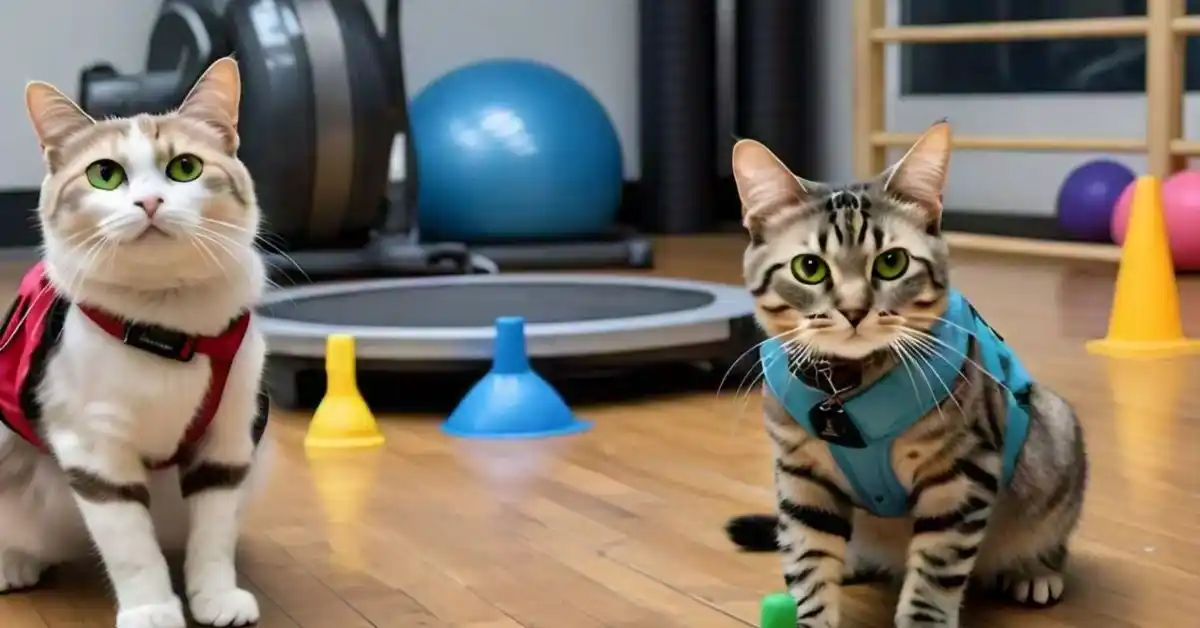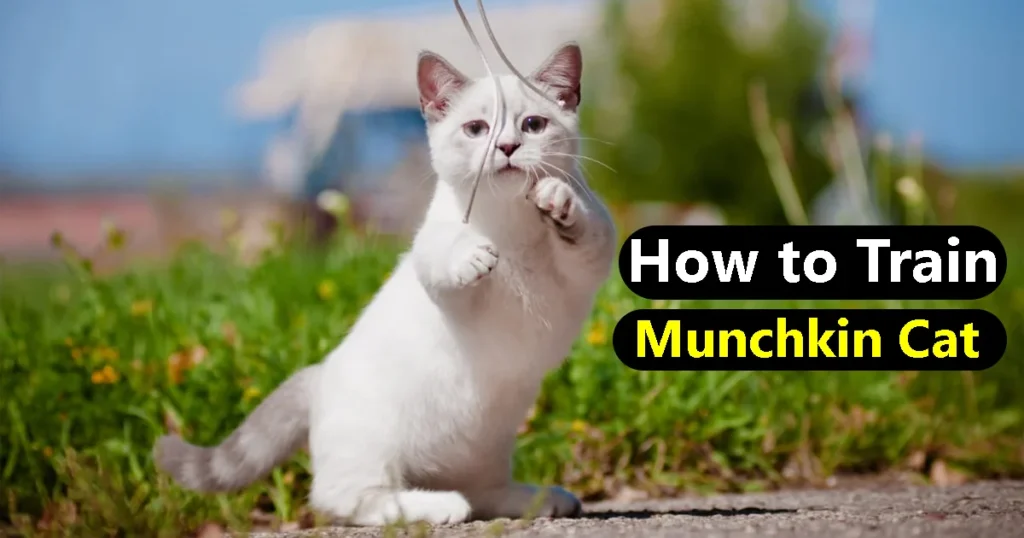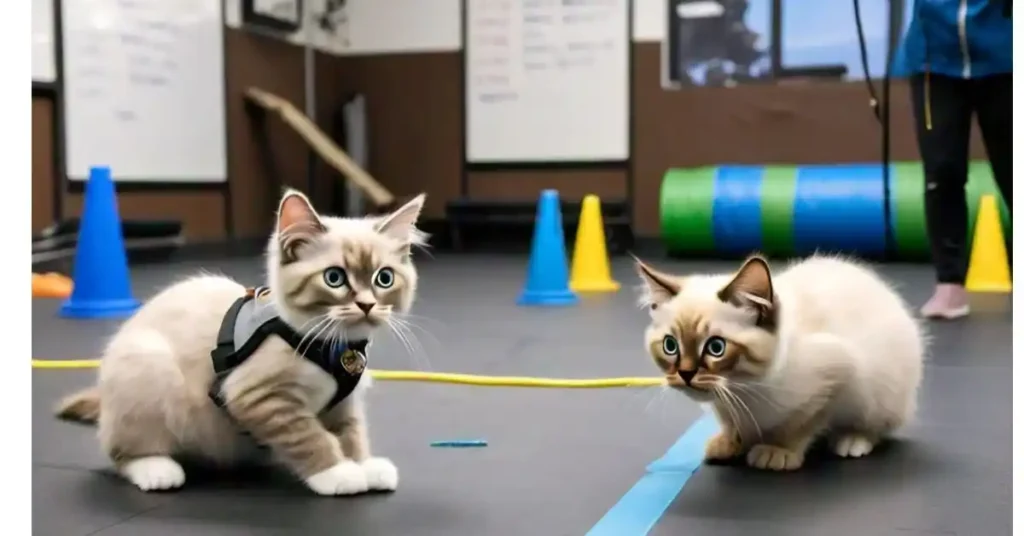Ragdoll cats can be trained using positive reinforcement methods such as clicker training and rewards. Engaging them in fun activities, providing mental stimulation through games, and consistent socialization can help shape their behavior and reduce undesirable habits, like scratching. It’s important to remember that patience and consistency are key to successful training.
Ragdoll Cat Training involves using gentle but firm commands and starting at a young age. Focus on consistent obedience training to establish good behavior. Engaging your Ragdoll with fun tricks and mental stimulation can also enhance training outcomes.
Ragdoll cats can indeed be trained, as they are intelligent and responsive to positive reinforcement. It’s effective to train them using treats, praise and affection which helps them learn commands like “come.” Training sessions work best when done around meal times making them more motivated to respond.
Ragdoll Cat Training: A Step-by-Step Guide
Ragdoll cats are known for their affectionate nature, calm demeanor, and intelligence, making them excellent companions. While their laid-back personality may seem to contradict the idea of training, Ragdolls are quick learners when motivated with love, treats, and patience.
This guide covers everything you need to know about training your Ragdoll cat, from basic commands to managing behavior and enhancing your bond.
- Affectionate and sociable: They love human interaction and thrive on attention.
- Gentle and calm: Training requires a soft, non-aggressive approach.
- Intelligent and curious: Ragdolls are receptive to commands and mental stimulation.
Training a Ragdoll cat is a rewarding process, as they are known for their affectionate, gentle nature and intelligence. Here’s a step-by-step guide to help you train your Ragdoll cat effectively:
1. Establish a Safe Environment
Create a calm, secure space for your Ragdoll to help them feel comfortable and confident. Start in a quiet room where they can acclimate to their new surroundings.
2. Build Trust and Bonding
Spend quality time with your Ragdoll, using gentle strokes, talking softly, and letting them come to you. Build trust by giving them space when needed and being patient.
3. Litter Box Training
Ragdolls are generally easy to litter train. Place them in the litter box after meals or naps, and reward them when they use it. Keep the box clean and in a quiet, accessible location.
4. Use Positive Reinforcement
Reward your cat with treats, praise, or affection when they perform a desired behavior. Consistently rewarding them for good behavior encourages repetition.
5. Start with Basic Commands
Begin with simple commands like “sit,” “stay,” or “come.” Use a calm voice and consistent cues. Hold a treat above their head to encourage sitting, and reward them immediately when they comply.
6. Leash Training
If you want to take your Ragdoll outside, introduce a harness and leash slowly. Start with short sessions indoors, allowing your cat to get used to the harness. Gradually increase outdoor exposure once they’re comfortable.
7. Playtime for Mental Stimulation
Incorporate interactive play with toys like feather wands or laser pointers to keep your Ragdoll mentally stimulated. These sessions will also reinforce the bond between you and your cat.
8. Socialization
Expose your Ragdoll to different people, pets, and environments slowly. This helps them build confidence and reduces the risk of fear or anxiety in new situations.
9. Patience and Consistency
Be patient throughout the process. Ragdolls are typically easy-going, but they may need time to learn new skills. Consistency is key to reinforcing good behavior.
10. End on a Positive Note
Always end training sessions on a positive note, even if progress is slow. Reward your cat for participating, ensuring that they associate training with fun and positive experiences.
By following this step-by-step guide, your Ragdoll cat will learn basic commands, good behaviors, and become more confident and comfortable in your home.
Training Your Ragdoll Cat: Essential Tips
Training your Ragdoll cat is a rewarding experience, as this breed is known for its affectionate and calm demeanor, making them receptive to learning. Here are some essential tips for training your Ragdoll cat:
- Start Early: Begin training when your Ragdoll is a kitten, as they are most impressionable at this stage. Early socialization helps them develop good habits and become comfortable with new experiences.
- Use Positive Reinforcement: Reward good behavior with treats, praise, or playtime. Ragdolls respond well to positive reinforcement, which helps them associate training with positive outcomes.
- Teach Basic Commands: Start with simple commands like “sit,” “come,” and “stay.” Keep training sessions short (5-10 minutes) to prevent your cat from losing interest.
- Litter Box Training: Ragdolls are typically easy to litter train, as they instinctively use the litter box. Ensure the box is clean and placed in a quiet, accessible area. Reward them when they use it properly.
- Scratch Training: Provide scratching posts and pads to satisfy your cat’s natural scratching instinct. Gently redirect your Ragdoll to these items if they scratch furniture or other unwanted areas.
- Leash Training: Ragdolls are often curious and enjoy exploring, so leash training can be an enjoyable way for them to safely explore the outdoors. Introduce a harness slowly and reward them for wearing it.
- Be Patient and Consistent: Training takes time, especially with a breed like the Ragdoll, known for its calm and relaxed nature. Be consistent with commands, rewards, and expectations to help them understand what you’re asking.
- Socialization: Ragdolls are social cats that enjoy interacting with people and other pets. Gradually expose your cat to different environments, people, and animals to ensure they become well-adjusted and confident.
By using positive training methods, patience, and consistency, you can develop a strong bond with your Ragdoll cat and help them grow into a well-behaved, loving companion.
Tips for Successful Training
Successful training of your cat, whether it’s a Ragdoll, Munchkin, or any other breed, requires patience, consistency, and a clear understanding of your cat’s natural instincts. Here are some tips to ensure success:
- Be Patient: Cats, especially kittens, may take time to learn new behaviors. Keep your expectations realistic and allow plenty of time for training. Don’t expect instant results—progress comes gradually.
- Use Positive Reinforcement: Reward your cat with treats, praise, or playtime when they perform a desired behavior. Positive reinforcement encourages them to repeat that behavior and strengthens your bond.
- Keep Sessions Short: Cats have short attention spans, so training sessions should be brief—around 5-10 minutes. Multiple short sessions throughout the day are more effective than one long session.
- Consistency is Key: Use the same commands and rewards each time. Consistency helps your cat understand what you expect and makes training more effective.
- Make It Fun: Incorporate toys and games into the training process. Cats are more likely to engage and enjoy the experience if it feels like play rather than a chore.
- Set Realistic Goals: Start with basic commands or behaviors, like sitting or using the litter box, and build up from there. Gradually increase the complexity of tasks as your cat becomes more comfortable with training.
- Provide a Calm Environment: Training should take place in a quiet, distraction-free environment. This will help your cat focus and learn more effectively.
- Respect Their Limits: Some cats may not be as eager to perform certain tasks, especially if they feel anxious or uncomfortable. Recognize when your cat is not in the mood to train and give them a break.
- Socialize Early: If you’re training a kitten, early socialization with people, other pets, and different environments can help your cat become well-adjusted and receptive to learning.
- Avoid Punishment: Never use harsh discipline or punishment, as it can cause fear and damage the trust between you and your cat. Instead, gently redirect unwanted behavior and reward positive actions.
By following these tips and remaining patient and consistent, you’ll create a positive and effective training experience for your cat.
Create a Supportive Environment
A positive training environment is vital for your Ragdoll’s success. Ensure that the training area is quiet and free of distractions, allowing your cat to focus better. Socialization is also essential; gently introduce your Ragdoll to new people, pets, and experiences to help them become well-adjusted and confident.
When it comes to litter box training, Ragdolls typically adapt quickly, so be sure to guide them to the box after meals and reward them for using it. Lastly, enrich their environment with interactive toys that stimulate their minds, providing both mental and physical exercise.
Understanding Your Ragdoll Cat training
Before starting any training regimen, it’s crucial to understand the nature of your Ragdoll cat. Ragdolls are known for their docile and relaxed demeanor, often going limp when picked up, which is where their name comes from. This breed generally enjoys human companionship and is less likely to exhibit aggressive behavior.
Address any behavioral issues like aggression with patience and positive reinforcement. Remember, every Ragdoll is unique, so tailor your training methods to suit their individual personality and needs. By investing time and effort into training, you strengthen your bond with your Ragdoll cat, ensuring they are well-adjusted, happy, and well-behaved.

Getting Started with Training
Training Ragdoll kittens early helps establish trust and encourages the development of desirable behaviors. Ragdoll cats are intelligent and inquisitive, making them ideal for training tricks and fetch using positive reinforcement. Spending quality time training and playing with Ragdoll cats strengthens the bond between the cat and owner.
Basic Commands and Skills
| Training Aspect | Details |
|---|---|
| Litter Training | Introduction: Start as soon as you bring your Ragdoll home by showing them the litter box and placing them in it after meals and naps. Location: Keep the litter box in a quiet, accessible area. Positive Reinforcement: Praise and reward your cat with treats when they use the litter box. |
| Name Recognition | Repetition: Use your cat’s name frequently with positive reinforcement. Reward: Offer treats and affection when they respond to their name. |
| Discouraging Biting or Scratching | Firm Command: Say “no” firmly when your cat bites or scratches. Redirection: Provide an alternative, like a toy, to redirect their behavior. |
Ragdolls respond best to positive reinforcement, so use treats, praise, and affection to reward desired behaviors, such as using the litter box or following commands. This method encourages them to repeat those actions. Clicker training which pairs a distinct sound (the click) with a reward, can also be effective.
Start by clicking the device and immediately offering a treat, helping your Ragdoll associate the click with a reward for more precise behavior shaping. Additionally, incorporating interactive play into training sessions is beneficial.
Engage your Ragdoll with toys that promote physical activity and mental stimulation, which aids in training while providing a healthy outlet for their energy.
Litter and Leash Training
Ragdoll Cat Training begin with litter training by choosing a suitably sized box and placing it in a consistent location, initially guiding your cat to it until they find it on their own. For leash training, introduce a comfortable harness and let your cat acclimate to it in a familiar setting then start with short indoor sessions before transitioning to outdoor walks.
For handling training, regularly touch your cat with positive reinforcement and prepare them for vet visits with gentle restraint. Advanced tips include using target training with a clicker for precision, maintaining a consistent daily routine for security, and setting up an agility course to challenge and engage your cat progressively.
Common Challenges Ragdoll Cat Training
Training Ragdoll cats can be an enjoyable experience, but like any breed, there are some common challenges to be aware of. Here are a few obstacles you may encounter and how to address them:
- Short Attention Span: Ragdolls are generally calm and easygoing, but they can also be easily distracted. Keeping training sessions short (5-10 minutes) and making them fun and engaging will help maintain their focus.
- Independence: Ragdolls are known for their laid-back, independent nature. While they are affectionate, they may not always be as eager to please as some other breeds. Be patient and consistent, as they may take longer to respond to commands.
- Over-Training: Ragdolls are not typically hyperactive cats, and over-training can lead to frustration or boredom. Avoid long training sessions, and instead, offer frequent breaks to keep the experience enjoyable for your cat.
- Litter Box Issues: Although Ragdolls are usually easy to litter train, some may be picky about the type or cleanliness of their litter box. Ensure the box is kept clean and placed in a quiet, accessible location. Experiment with different litter types to find the one your cat prefers.
- Scratching Furniture: Like many cats, Ragdolls have a natural instinct to scratch. While they are generally docile, they may scratch furniture or carpets if not provided with adequate scratching posts. Ensure there are plenty of alternatives, and gently redirect them when they scratch the wrong area.
- Reluctance to Leash Training: While Ragdolls are curious, they may not always take well to leash training. Introduce the harness slowly and associate it with positive experiences, such as treats or play, to help your cat adjust to it.
- Separation Anxiety: Ragdolls are known for being social and may struggle with being left alone for long periods. This can lead to unwanted behaviors such as excessive meowing or destruction. Gradually increasing time apart and providing mental stimulation, like puzzle toys, can help ease their anxiety.
By understanding and addressing these challenges with patience and positive reinforcement, you can ensure a smooth training experience for your Ragdoll cat.
Tips for Successful Training
Tailor your Ragdoll Cat Training approach to suit your Ragdoll’s individual personality and preferences. Pay attention to their body language and adjust your methods accordingly.
FAQs
Can Ragdoll cats be trained like dogs?
Yes, Ragdolls can learn commands, tricks, and even leash walking. Their intelligence and social nature make them highly trainable.
What is the best age to start training a Ragdoll cat?
Start training as early as possible, ideally when they are kittens (around 8-12 weeks). However, adult Ragdolls can also learn new behaviors with patience.
Do Ragdolls enjoy training sessions?
Ragdolls enjoy the bonding experience of training, especially if sessions involve treats, toys, and praise.
Are there any training techniques I should avoid?
Avoid using punishment or physical force in training, as this can damage your relationship with your cat and lead to fear or aggression. Stick to positive reinforcement methods that focus on rewarding desired behaviors.
Can older Ragdoll cats still be trained?
Yes, older Ragdoll cats can still learn new behaviors through patient, consistent training. While it may take longer than with a kitten, it’s never too late to start training and strengthening your bond with your pet.
Conclusion
Training your Ragdoll cat is a rewarding journey that deepens the bond between you and your feline friend. By understanding their unique traits and employing effective training techniques, you can nurture a harmonious relationship built on trust, respect, and mutual understanding.





